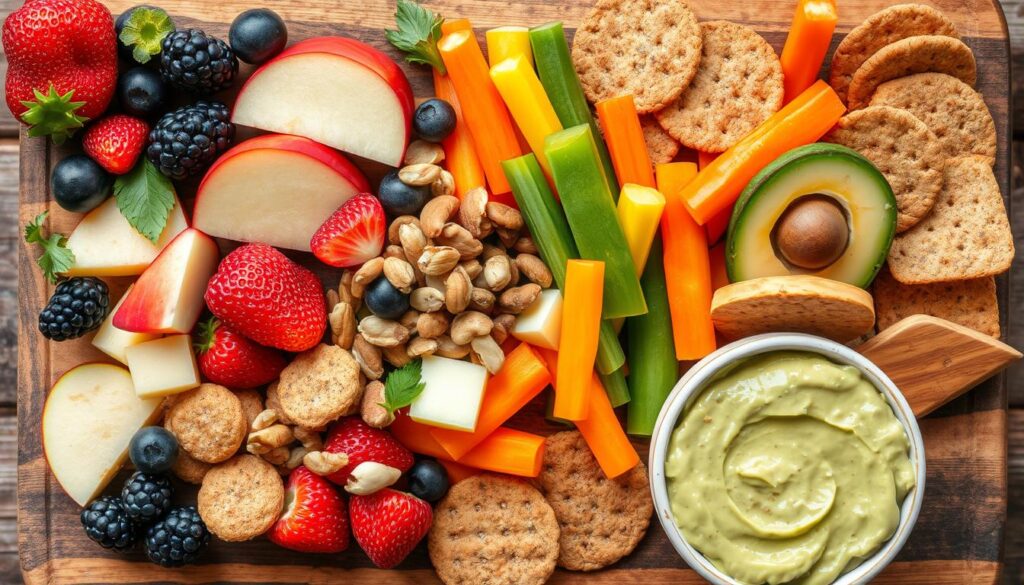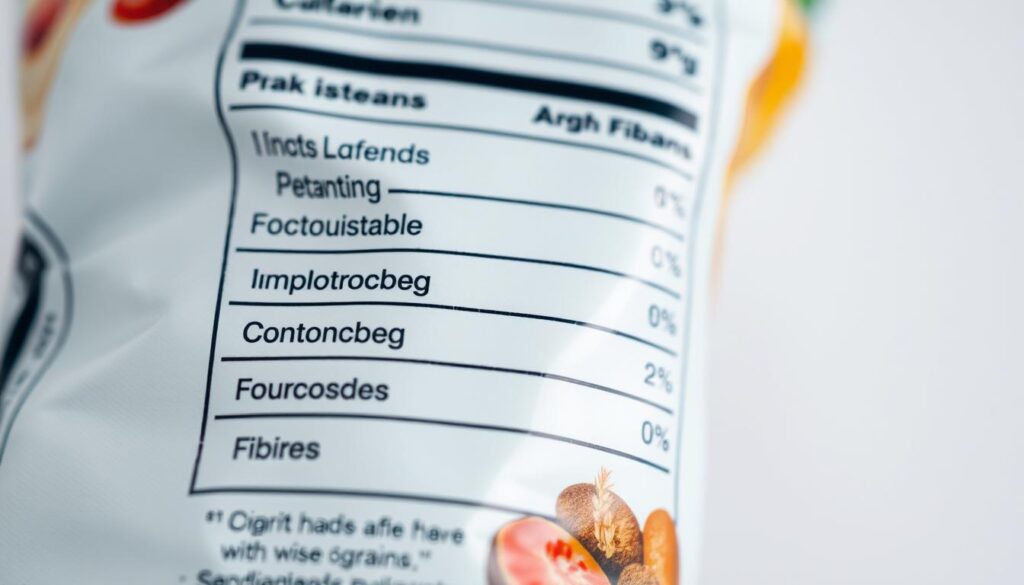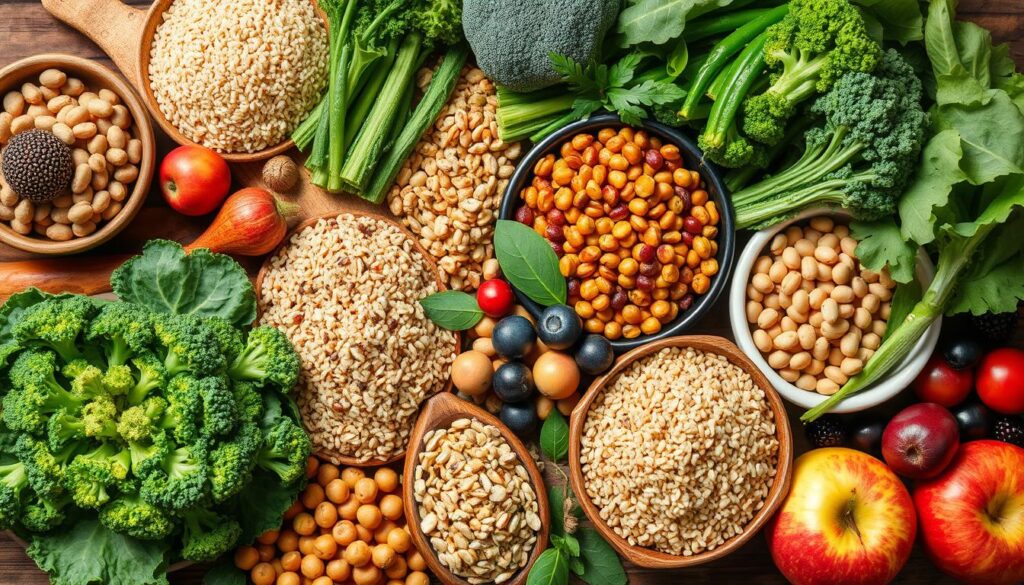If you have diabetes, managing your blood sugar is very important. Eating foods high in fiber is a big help. Fiber helps keep your blood sugar stable, keeps your digestive system healthy, and lowers heart disease risk. But, most U.S. adults don’t get enough fiber.
The American Diabetes Association and the 2020-2025 Dietary Guidelines say adults should eat 22 to 34 grams of fiber each day. By choosing high-fiber foods, you can help control your blood sugar and stay healthy.
Key Takeaways
- Fiber is essential for managing blood sugar levels in people with diabetes.
- The recommended daily fiber intake for adults is 22-34 grams, but most Americans fall short.
- High-fiber foods can help control blood sugar, support digestive health, and reduce the risk of heart disease.
- Incorporating a variety of high-fiber foods, such as whole grains, legumes, and fruits and vegetables, is key to a healthy diabetes diet.
- Gradually increasing fiber intake can help prevent digestive discomfort like bloating or gas.
Understanding Fiber’s Role in Diabetes Management
Eating a diet rich in fiber is key for people with diabetes. Fiber is a part of plant foods that our body can’t digest. It helps keep blood sugar levels steady by slowing down how carbs are digested.
What is Dietary Fiber?
Dietary fiber is very important for health, especially for those with diabetes. It helps control blood sugar and aids in weight loss. It also lowers cholesterol and cuts down heart disease risk.
Benefits for Blood Sugar Control
Studies show that enough soluble fiber can lower heart disease risk by reducing bad cholesterol. The American Diabetes Association (ADA) says people with diabetes should eat at least 14 grams of fiber for every 1,000 calories to manage their diabetes.
Daily Fiber Requirements
The amount of fiber you should eat changes with age and sex. Women aged 19 to 30 should eat 28 grams of fiber a day. Women aged 31 to 50 should eat 25 grams. Men aged 19 to 30 should eat 34 grams, and men aged 31 to 50 should eat 31 grams. Men 51 and older should eat 28 grams of fiber a day.
Eating different plant-based foods all day can help you meet these fiber needs. This supports your health and well-being.
Types of Fiber: Soluble vs. Insoluble for Glycemic Control
Managing diabetes means knowing about dietary fiber. It’s key for keeping blood sugar in check. There are two main types: soluble and insoluble.
Soluble fiber turns into a gel in water. It slows down carb absorption, which helps control blood sugar and lowers cholesterol. You can find it in apples, oats, beans, and citrus fruits.
Insoluble fiber doesn’t mix with water. It makes your stool bulkier, helping with regular bowel movements. You’ll find it in whole-wheat flour, nuts, and veggie skins.
Both soluble and insoluble fiber are important for health and blood sugar control. Eating foods rich in both can help manage blood sugar and improve overall health.
| Soluble Fiber | Insoluble Fiber |
|---|---|
| Dissolves in water, forming a gel-like substance | Does not dissolve in water, adds bulk to stool |
| Slows down the absorption of carbohydrates, helps regulate blood sugar | Promotes regular bowel movements and supports digestive health |
| Found in foods like apples, oats, beans, and citrus fruits | Found in whole-wheat flour, nuts, and vegetable skins |
Knowing about soluble and insoluble fiber helps you make better food choices. This supports your blood sugar regulation and overall health.
High Fiber Foods Diabetes: Essential Foods List
Managing diabetes means eating foods high in fiber. Fiber helps control blood sugar and keeps it stable. It also makes digestion better. Here are some top fiber-rich foods for your diet.
Whole Grains and Cereals
Whole grains like oats, brown rice, and quinoa are full of fiber. A half-cup of oats has about 5 grams of fiber. You can also try whole wheat bread, barley, and bulgur for more fiber.
Legumes and Pulses
Legumes and pulses, like lentils and chickpeas, are fiber-packed. Lentils give you about 7 grams of fiber per half-cup. Chickpeas have 7 grams per 35-gram serving. Add them to soups, stews, and salads for more fiber.
Fruits and Vegetables
Fruits and vegetables are also rich in fiber. Bananas have 3.3 grams of fiber per medium fruit. Pears offer 5.6 grams per fruit. Brussels sprouts and artichokes are also good sources of fiber.
Eating a variety of these high-fiber foods helps meet your daily fiber needs. The 2020-2025 Dietary Guidelines suggest adults eat 28 to 34 grams of fiber daily. So, include these foods in your meals and snacks for better blood sugar control.
“Fiber is essential for individuals with diabetes, as it helps slow the absorption of carbohydrates and stabilize blood sugar levels. Incorporating a variety of high-fiber foods into your meals is a simple yet effective way to manage your diabetes.”
The Power of Beans and Lentils for Blood Sugar Management
Beans and lentils are great for managing blood sugar. They have lots of fiber and resistant starch. These help control blood sugar and keep your body healthy.
One ¼ cup of cooked red kidney beans has 5 grams of fiber. Black beans have 6 grams in half a cup. They also have fatty acids that help with insulin and colon health.
Eating beans and lentils every day can help control blood sugar. Try adding them to salads, soups, or main dishes for an easy way to reap the benefits.
“Beans and lentils are a diabetic superfood – they provide a powerful one-two punch of fiber and resistant starch to help keep blood sugar in check.”
Research shows beans have a lower glycemic response than other foods. Just ¼ cup can help manage diabetes. This makes them easy to add to your diet.
So, if you want to control your blood sugar, eat beans and lentils often. They are good for your blood sugar and health.
Smart Snacking with Fiber-Rich Options
Keeping blood sugar stable is key for type 2 diabetes. Fiber-rich snacks can really help. They stop blood sugar from spiking and keep you full and energized.
There are many tasty and healthy snacks to try. Crunchy nuts, portable hummus, and veggie packs are all great choices.
Nuts and Seeds
Nuts like almonds, walnuts, and pecans are full of fiber and protein. They’re great for snacks. One ounce of almonds has 4 grams of fiber.
Chia seeds are also super fiber-rich. They have 5 grams of fiber per tablespoon. You can add them to yogurt, smoothies, or enjoy them alone.
Healthy Portable Snacks
- Air-popped popcorn: This snack is low in calories and has 1.15 grams of fiber per cup.
- Hummus and veggie sticks: Chickpeas in hummus are fiber-rich. They go well with crunchy carrots, celery, or bell peppers.
- Edamame: These soybeans are tasty and have 8 grams of fiber per cup.
Portion Control Tips
It’s crucial to control snack portions to keep blood sugar steady. Measure out nuts, seeds, and other snacks. Choose pre-portioned ones when you can.
This helps avoid eating too much. It ensures you get the right nutrients for managing diabetes.

“Fiber-rich snacks can help stabilize blood sugar levels in individuals managing type 2 diabetes.”
Incorporating Fiber into Your Daily Meal Plan
Boosting your fiber intake is key for managing diabetes and a balanced diet. Start with fiber-rich breakfasts like avocado toast with chickpeas or oatmeal with nuts and berries. For lunch and dinner, pick whole grains over refined ones. Add non-starchy veggies to your meals.
Legumes, like beans, lentils, and chickpeas, are great for fiber. You can add them to salads, soups, and casseroles.
Snacking can help too. Choose nuts, seeds, or whole fruits over processed snacks. Slowly add more fiber to avoid stomach issues. Drink lots of water to help digest it.
- Start your day with a fiber-friendly breakfast, such as avocado toast with chickpeas or oatmeal with nuts and berries.
- Choose whole grains over refined options for lunch and dinner, and add a variety of non-starchy vegetables to your meals.
- Incorporate legumes, like beans, lentils, and chickpeas, into your dishes to boost fiber content.
- Snack on nuts, seeds, or whole fruits to increase your daily fiber intake.
- Gradually increase your fiber intake and drink plenty of water to support healthy digestion.
Adding more fiber-rich meals to your day can greatly help with diabetes and health. Simple changes in your diet can lead to big health benefits.
“A high-fiber diet has been shown to significantly improve blood sugar control in individuals with type 2 diabetes, according to a study published in Diabetes Care.”
Reading Food Labels for Fiber Content
Understanding food labels is key for managing fiber intake with diabetes. The FDA has rules for labeling fiber content. Foods with 5 grams or more per serving are “high” in fiber.
Products with 2.5 to 5 grams per serving are “good” sources of fiber. This helps you meet your daily fiber goals.
Understanding Fiber Values
Look at the total dietary fiber on nutrition labels. This tells you if a food meets your daily fiber needs. Remember, serving sizes can differ, so check the label well.
What Makes a “Good Source” of Fiber?
- Foods with 10% or more of the daily fiber value (2.5-5g per serving) are “good” sources.
- Foods with 20% or more (5g or more per serving) are “high” in fiber.
- It’s important to compare fiber content to serving size to find fiber-rich foods.
Learning to read food labels helps you find high-fiber foods. These foods can help control blood sugar and support health. Fiber is vital for everyone, but especially for diabetes management.

Potential Side Effects and Precautions
Adding more fiber to your diet can help with diabetes. But, start slow to avoid stomach problems. Too much fiber can cause bloating, gas, or tummy troubles. Drink lots of water to help.
If you still have stomach issues, talk to your doctor. People with diabetes might need to watch their carbs more when eating more fiber. This helps keep blood sugar levels right.
The National Academy of Medicine suggests how much fiber adults should eat:
- 21 grams for women older than age 50
- 30 grams for men older than age 50
- 38 grams for men age 50 or younger
Fiber is good for your health, like digestion and blood sugar. But, sometimes, less fiber is better, like during stomach problems. Always ask your doctor about your fiber needs.
Adding fiber to your diet is a slow step. Start small and drink plenty of water. This way, you can enjoy better digestion and blood sugar without side effects.
Conclusion
Eating foods high in fiber helps control diabetes and blood sugar. Choose whole grains, legumes, fruits, and veggies. They help you meet your fiber needs and offer many health benefits.
Studies show fiber can lower blood sugar and improve control. It also cuts down on diabetes complications.
People with diabetes need 22-35 grams of fiber daily. But most get only 16 grams. Swapping to fiber-rich foods can help manage blood sugar and improve health.
Start adding more fiber to your diet slowly. Drink plenty of water and talk to your doctor or dietitian. With the right diet and lifestyle, you can manage diabetes well.


A Life-Changing Experience with This Weight Loss Supplement (Nagano Tonic)
I’ve always struggled with finding a weight loss solution that actually works for me. Like many, I’ve tried numerous diets, exercise routines, and supplements over the years—some worked for a short time, but nothing ever gave me long-term results. That was until I decided to try the weight loss supplement I found : Link to the Supplement.
From the moment I started using it, I noticed a difference. Not only did I feel more energized, but my cravings also became more manageable. The best part? I started seeing results much quicker than I anticipated! Over the course of just a few weeks, I noticed a significant reduction in belly fat and overall weight loss that I hadn’t been able to achieve before.
What makes this supplement stand out from all the others I’ve tried is how it supports me in my daily routine without any jitters or energy crashes. I’m able to stay focused and motivated, which has made it easier to stay on track with my diet and exercise plan.
This product truly exceeded my expectations, and I feel more confident and healthier than ever before. If you’re struggling with your weight loss journey like I was, I highly recommend giving this supplement a try. It’s been a game-changer for me, and I’m sure it can work wonders for you too!
Contant Them on email .. tonicnagano50@gmail.com
I’ve tried so many weight loss products over the years, but nothing worked like this supplement! Since I started using it, I’ve noticed a big difference in my energy levels and appetite control. In just a few weeks, I’ve lost weight and feel so much better. It’s been easy to stick with, and the results speak for themselves. Highly recommend this to anyone looking to make a real change!
wasn’t sure what to expect, but this weight loss supplement has really impressed me! After just a few weeks of use, I’ve already dropped a few pounds and feel more motivated to stay active. It’s helped curb my cravings and boosted my energy throughout the day. I’m excited to keep going and see even better results. Definitely worth trying!
Reach them on tonicnagano50@gmail.com
I was skeptical at first, but this supplement has truly made a difference in my weight loss journey. I’ve lost weight without feeling deprived or sluggish. My cravings are under control, and I feel more confident in my body. It’s easy to incorporate into my daily routine, and the results speak for themselves. I’m so glad I gave it a try!
Thanks David, i do use the link to make my purchase. you can get too here http://surl.li/iasppy
I’ve tried so many weight loss products, but this one has been by far the most effective. In just a few weeks, I’ve noticed a visible difference in my body and energy levels. It’s helped me stay on track without the constant hunger pangs and cravings. I’m really happy with my progress and can’t wait to see where I’ll be in another month!
This Nagano Tonic has been amazing! In just a few weeks, I’ve lost weight, feel more energized, and my cravings are under control. Highly recommend it!
Thats the link to purchase http://surl.li/iasppy